(This page has relied on documents translated from French using on-line translation engines, which are challenged by technical terms, so some of the phraseology may be a little awkward - thanks for your understanding!)
History
In 1958 the SNCF embarked on a dieselisation program specific to its secondary lines and certain principal lines that were not scheduled for electrification. Assisting in this task had been the growth in horsepower from the engine manufacturers. The SNCF were looking at power units in the 1,200hp to 3,000hp category. Specifically three manufacturers products were looked at:
SEMT-Pielstick 16PA producing 2,000hp BB 67000 classThe SNCF hoped the SEMT Pielstick would produce 2,400hp on future builds of the 67000 class as the Sulzer 12 LVA and AGO V12 DSHR were hoped to produce 3,000hp.
Sulzer 12LVA24 producing 2,700hp on A1A A1A 68000 class
AGO V12 DSHR producing 2,700hp on A1A A1A68500 class (sub class of 68000)
From Sulzer the SNCF utilised eighty three 12LVA24s in five separate orders between June 1961 & December 1965, to be installed in the 68001 - 68081 series locomotives, eighty were installed in the 68001 - 68081 batches, less 68005 which from new was equipped with an AGO engine, and three spare engines. The remarkable styling of these machines was due to the talent of Paul Arzens and the production was in co-operation with the four primary subcontractors:
Compagnie de Ateliers et Forges de la Loire (CAFL) at St Chamond, with assistance from Fives-Lilles-Cail Company at Givors were responsible for the bodywork and bogies.This story includes many references to the SNCF 68500 Class locomotives powered by the AGO V12 DSHR engines, these locomotives were externally and internally exactly similar to the SNCF 68000 series except for the diesel engine and it’s governor, even the main generator was the same, although the 68500 series did not use the third winding, for shunt exctitation, due to to higher rotating speed provided by the AGO Diesel. The 68000 series and the 68500 series would feature re-engining of both types using each others power units. Although both Classes had a long life span, at the end the AGO powered locomotives outlived the Sulzer powered variant due to the final better availability of spares for the AGO engines.
Compagnie Electro-Mecanique (CEM) at Bourget provided the electrical equipment.
Compagnie de Constructions Mecanique (CCM) at Mantes built the Sulzer power units.
Orders 68000 Class:
68001 - 68020 June 7th 1961 - delivered 7/63 - 11/64
68021 - 68042 June 6th 1962 - delivered 12/64 - 10/65
68043 - 68060 August 6th 1963 - delivered 12/65 - 11/66
68061 - 68074 September 30th 1964 - delivered 12/66 - 07/67
68075 - 68081 December 29th 1965 delivered 11/67 - 08/68
(68082 - 68085 re-engining from 68500 series)
Orders 68500 Class:
68501 - 68508 August 6th 1963 (with integration of 68005 / 68501 produced in the first 68000 batch) - delivered 12/63 - 11/65
68509 - 68521 September 30th 1964 - delivered 11/66 - 4/67
68522 - 68529 December 29th 1964 - delivered 6/67 - 6/68
(68529 - 68540 re-engining from 68000 series)
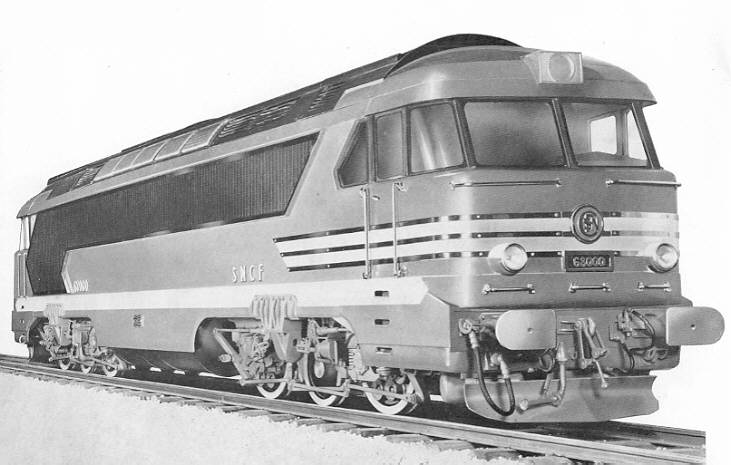
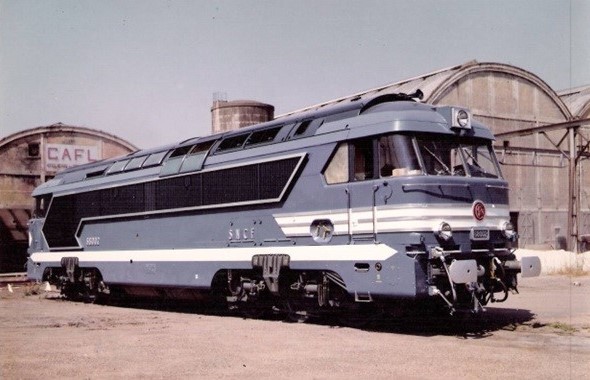
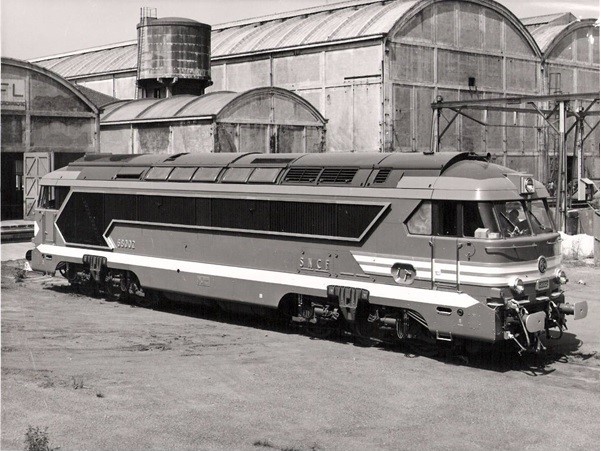
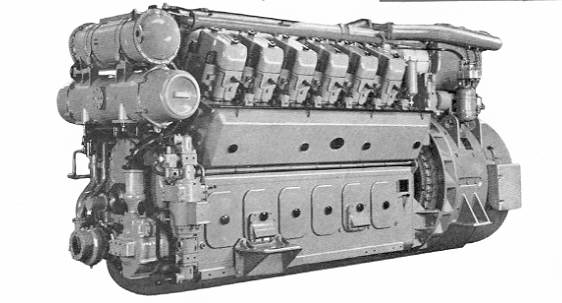
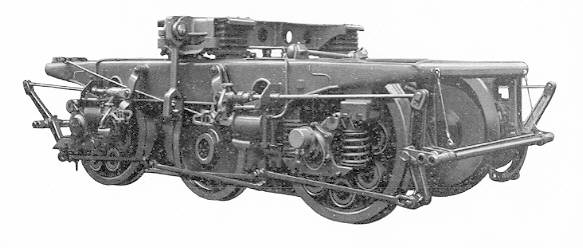
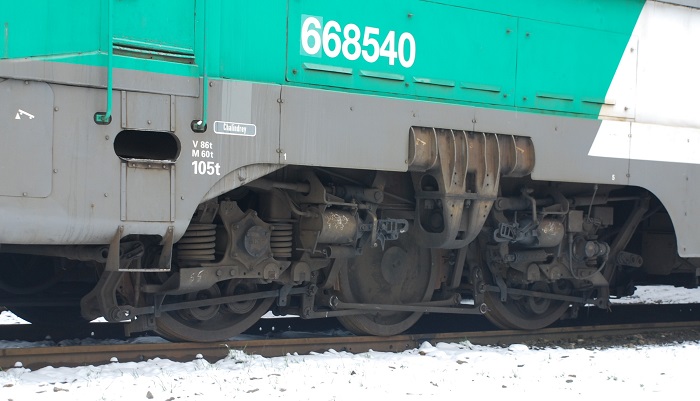
1963 - 1970
By the summer of 1963 the SNCF had about 3,000 steam locomotives remaining on the roster, many of which were large machines in good condition. At this time the first deliveries of a number of new diesel locomotive types, of 2,000bhp or more were being delivered from various manufacturers. These included members of Classes 67000 & 68000. To this point the SNCF had been content with diesel locomotives in the 1,800bhp to 2,000bhp range, though its large fleet of electric locomotives for some time had been operating with many locomotives producing 3,000 to 5,500bhp and 7,900bhp with CC6500 in 1970. For the electric locomotives power was recorded at the wheel rim, for the diesel locomotives it was at the crankshaft.
For the 68000/68500 Class they would be initially allocated to five depots in the East, West, South-West and South-East Regions. These depots would be Caen, Chalindrey, Chambery, Limoges and Rennes. One of their tasks would be to take over duties handled by steam locomotive classes 141 E,F,P & R, 231 D,G & K & 241 A & P.
The first depot to receive the 68000 class would be the Eastern Region depot of Chalindrey, situated about 300km south-east of Paris. Chalindrey took delivery of the first three 68000 series in the second half of 1963.
During June & July 1963 testing of the first units of each sub-series were carried out utilising Dynamometer Car No.4. Numerous starting tests on gradients of 11 mm/m were carried out with various tonnages and on good rail without sanding, the performances of the locomotives was successful. Tests on other lines with steeper gradients, including long grades of 25mm/m as on the Alps line between Grenoble and Veynes confirmed the abilities of these locomotives.
They were used on several heavy express services between Paris and Mulhouse, at first mainly between Paris and Chaumont with steam haulage after Chaumont, loading to 850 tons. By the end of September 1963 they had taken over other passenger services.
In accordance with the usual practice of the SNCF, track holding tests with single locomotives and double headed at speeds reaching 140 km/h were carried out on sections of track specially chosen due to their unfavorable condition. These tests totalled 6,850 km.
Also during June & July 1963 68001 was recorded under test on the Paris - Cherbourg line, hauling 560 tons as far as Caen, the load reduced to 450 tons between Caen & Cherbourg. Although the line limit was 120 km/h a maximum speed of 130 km/h was achieved during these tests. Journey times between Paris & Caen based on these trials would see thirty minutes cut off the schedule.
During the latter half of 1963 they were averaging 11,000 km, with at least one daily diagram reaching 1,200km. From mid-December 1963 with more deliveries to Chalindrey depot they were placed on St Dizier - Chalindrey - Dijon and Nancy - Epinal - Port d'Atelier services.
Late in November 1963 Caen received brand new 68004, taking up round-trip passenger services between Paris and Caen, achieving almost 1,000km daily. Speeds reached just under 100km/h with one way trips taking under three hours. Between January and August 1964 Caen would received nine further 68000 series, alongside the 67000 series they would handle the Paris - Caen - Cherbourg and Paris - Trouville services. By December 31st 1964 Caen was responsible for 68004/06/09/10/11/12/14/15/16&17. As more locomotives were delivered they were utilised on the express passenger trains on the Rouen - Mezidon - Le Mans -Tours lines.
In the middle of December 1964 Limoges received brand new 68022 which was used for training locomotive crews and maintenance staff. By the summer four other 68000s had been received at Limoges allowing replacement of steam on such routes as Périgueux - Puy-Imbert, Limoges - St Sulpice - Lauriere - Montlucon - Gannat, Limoges - Périgueux, Périgueux - Coutras, Périgueux - Mussidan, Coutras - Montpont and Limoges - Agen. Some of these daily journeys totalled 402 km.
The Limoges allocated machines added to their routes including Bordeaux - Lyon as far as Gannat, and locations such as La Rochelle, Toulouse, Sévérac-le-Chateau, Aurillac, Bort-les-Orgues, Le-Mont-Dore, Clermont- Ferrand, Nevers, Tours-St-Pierre and St Germain-des-Fosses. By January 1st 1968 Limoges had seventeen 68000 series locomotives. At the begining of August 1968 Limoges took delivery of the last machine in the series, 68081.
The Limoges locomotives used the possibility of setting the primary suspension to give 18 tons maximum axle load on driving axles and 17 tons on the central axles in order to operate on ex-Paris - Orleans secondary lines equipped with light bullhead rail.
In the first week of March 1965 Chambery received brand new 68023, the first of six, with 68025, 68027, 68029 being delivered in March & April. With steam in the Chambery area in decline, the Classes 66000, 67000 & 68000 took over in the Dauphine-Savoie area, operating mixed passenger and RA (accelerated) freight services of the Etoile de Grenoble lines, including the routes Grenoble - Lyon, Grenoble - Chambery, Chambery - Bourg - St-Maurice and Valence - Chambery.
In April 1965 Rennes received 68013 from Caen for crew training, whilst towards the end of May 1965 brand new 68030 was delivered to Rennes. By the end of 1965 Rennes depot was home to 68013/30-43/45. These new arrivals would take work from the 141 P steam locomotives on the services from Rennes to Brest & Quimper, with poor availability.
In 1966 Rennes received three more 68000s, the last delivery to Rennes would be 68069 at the begining of February 1967. By May 1967 Rennes had a fleet of twenty-eight 68000s machines, almost one third of the fleet, with 68004/06/12/13/15/17/30-42/45/61-67/69. They would run some good mileages, with 68006 reported as running 22,982km in August 1968.
In November 1966 the Tours-St-Pierre depot received members of the 68000 series. During April 1967 at least three 68000s gained worked on express passenger services and freights couriers on the lines Tours - Angers, Tours - Vierzon, Tours - St-Germain-des-Fosees, St-Germain-des-Fosses - Sainte Etiennes, covering up to 883km daily. From the summer of 1967 they replaced the ex-PLM 231 G & K on the Nantes - Lyon and Tours - Paris via Vendome.
As Chalindrey received more of the 68500 series, its allocation of the ten 68000s were transferred to Chambrey, Tours and Limoges during 1967.
During the first years of activity and before the arrival of the CC72000 class, their average kilometrage was 25,000km per month and was identical for both the 68000 models.
In 1967 Chambrey received brand new 68071 & 68073 and also two 68000s transferred from Chalindrey. By the end of 1967 Chambery had fifteen 68000s, which would gradually replace the 67000s headed for Clermont.
On June 30th 1967 the sixty nine 68000s were allocated as follows:
Caen: 11
Rennes: 22
Limoges: 15
Tours: 7
Chambery: 14
The Winter Olympic Games in Grenoble in February 1968 saw the 141 class steam locomotives at Chambery replaced by sixteen 68000s transferred from the west and south-west regions and eight 68500s, this allocation was effective between November 1967 and February 1968 to handle the additional traffic.
The 68000s at Chambery would lose ground in 1967 to new Venissieux 72000s and continued electrification. They would be removed from the Grenoble - Lyon services, but gained the Tarentaise service and the Bellegarde - Evian line.
Tests were also carried out on Vitry bank with 68505 (1965) and 68039 (1968).
During 1968 the depot at Rennes had been receiving the more powerful 72000 series, leading to its fleet of 68000 series being gradually transferred to Caen during the fourth quarter of 1968. At Caen they were used to continue the dieselization of the Paris - Granville line allowing for the storage of the 141 P from Argentan and the 141 R from Mezidon.
On January 1st 1969 the eighty 68000s were allocated as follows:
Caen: 17
Rennes: 18
Limoges: 23
Tours: 7
Chambery: 15
In 1969 the arrival of brand new 67300s at Tours-St-Pierre saw 68018-22/24/26 transferred to Limoges for winter service, increasing the 68000 fleet at Limoges.
1970 - 1979
As the 68000 class entered the 1970s the decision was made to centralise the fleet at Caen and Limoges, with arrivals of electric train heating equipped 67300 & 67400 powered by the 2,400bhp 12PA Pielstick engine and now as powerful as the derated 68000s. Some of their work on the Paris - Cherbourg line had been taken over by the ETG and RTG turbo trains, but they were still used on passengers peak traffic on weekends to help the turbotrains, running at 130km/h to limit loss of time. This led to their use on other routes as they became familiar with the Rouen - Amiens line. From Amiens they then covered the lines to Boulogne, Calais, Lille, Tourcoing and Laon. These lines were added to their footprint of Paris - Cherbourg, Paris - Granville, Paris - Trouville - Deauville, Caen - Rennes, Rouen - Dieppe, Rouen - Le Mans, Le Mans - Nantes, Paris - Gisors and Le Mans - Nogent-le-Retrou.
During January 1971 the arrival of forty Classes 72000 and 67400 with electric train heating led to the Rennes 68000 fleet being transferred to Caen, the last examples leaving Rennes November 1971.
Likewise during 1971 the 68000 fleet at Chambery underwent changes with twelve machines transferred to Caen. The continued delivery of Classes 67300 to Chambery, 67400 and 72000 to Venissieux and the electrification of the Bellegarde - Annemasse line saw the last two 68000s transferred away from Chambery in January 1972.
In the spring of 1972 two 68000s were briefly transferred from Caen to Chalindrey.
On June 30th 1974 the eighty one 68000s were allocated as follows:
Chalindrey: 1
Caen: 60
Limoges: 20
A high speed derailment of 68062 and its passenger train at Dol de Bretagne on August 4th 1974, caused the deaths of eight passengers, the driver and the guard (conductor). The locomotive was taken out of service but not withdrawn until December 1976.
After the arrival of the alternator equipped series 67300/400 and CC 72000 for use on the main passenger services the monthly average mileage for some machines dropped to 13,500km in the mid-1970s, despite their increased use on freight services, though Caen 68000 still saw use on extra passenger services at weekends, holidays and in support of 'Turbotrains'.
In September 1975 all of Limoges 68000s were transferred away after the depot received fifteen 67400s and 67630/31/32, the 68000s were sent to Tours-St-Pierre depot, for use on the RA and RO freights and seasonal passenger use on the Nantes - Lyon, Vierzon - Montlucon, Le Mans - Tours and Saumur - Thouars lines. On the last mentioned route they handled stone trains of 3,000 tons, with one 68000 assisted by two 68000s in the rear between Thouars and Saumur, the multiple units continuing alone from Saumur to St Pierre des Corps after the turnround at Saumur.
During the latter half of 1976 Caen received seven 67300 series which were equipped with electric train heating equipment and allowed to 140km/h, leading to these locomotives taking over passenger services previously handled by the 68000s series. Sixteen 68000s were transferred from Caen to Tours between January & April 1977. These were used on Tours - St-Germain-des-Fosses services, freight services to Gravanches and occasionally the Moulins - Paray-de Monial line.
Late in January 1977 the Quatre-Mares workshops received 68009 for repair, it was first 68000 to undergo mid-life RG with cab reinforcements, being returned to traffic at the end of April to join Tours depot.
1980 - 1989
At the begining of the 1980s the depots at Caen & Tours removed its 68000s from passenger services.
At some point in 1980 68002 (still fitted with an original cab) was involved in a terrible collision in Persan-Beaumont yard, (a collision with another train due to the mistake of a signaller) regrettably the two crew members were killed.
With the electrification of the Bordeaux - Montauban line, Bordeaux was able to release its 67300s to Caen, which also received some 67400 series, allowing Caen in April 1980 to send eighteen 68000s to La Plaine (Paris). This would allow for retirement of some of La Plaine's venerable 65500 series 'Dakotas' and for their use in support of the construction of the South-East TGV line - quite an irony the Sulzer LVA powered locomotives were replacing Sulzer LDA locomotives! The eighteen 68000s were transferred between April & October 1980, being 68008/10/15/20-24/30/36-42/46/47. Their activities included freight traffic to the north of Paris, the port of Gennevilliers, new cars trains from Bourget to Trappes or Juvisy, and freights on the routes Le Bourget - Saint-Ouen - Gennevilliers, Le Bourget - Soissons, Creil - Beauvais and Creil - Acheres via Persan-Beaumont. Whilst at La Plaine the 68000s had only a few passenger workings: Creil - Beaumont, Paris - Le Treport and Paris - Beauvais.
Between May 1982 and October 1983 Caen saw its residual 68000s transfered to Chalindrey, then Nantes and then back to Chalindrey (68004 - 68032). These locomotives were needed to cover the diversions of RA and RO freight trains via Diemeringen - Obermodern and Epinal - Lure due to the work being carried out on the Paris - Strasbourg line tunnels at Noederrheinberg and Lutzelbourg.
On May 28th 1982 a derailment on a tall viaduct at Xertigny involving 68028 & 68501 saw 68028 fall from the viaduct causing severe damage to the locomotive. Two workers were killed and at least five injured. 68028 was retired from service, having only just arrived on transfer to Chalindrey.
The electrification of the Etoile d'Angers lines in September 1983 reduced the number of diesels required of the depots at Tours and Nantes. Greatly reduced in number at Nantes were Classes 63500, 66000 and 66400. But late in September 1983 seventeen 68000s from Caen & Tours were transferred to Nantes - Blottereau for the Nantes - Bordeaux line. They also worked freights on the Nantes - Lorient - Quimper line and its branches and handled heavy stone trains in the Thouars basin.
On December 30th 1983 the eighty one 68000s were allocated as follows:
Chalindrey: 13
La Plaine: 18
Nantes: 17
Tours: 33
When La Plaine closed in 1987 the 68000s were transferred to Chalindrey and Tours.
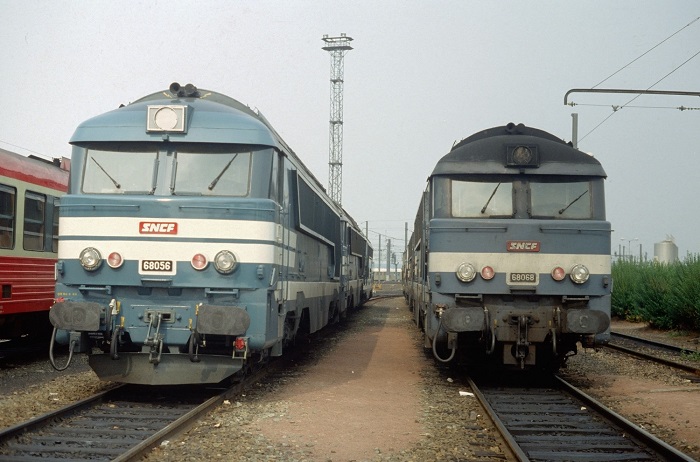
1990 - 1999
In September 1991 ten machines were transferred to Chalindrey 68001/07/09/11/12/13/18/25/29/35 following the commissioning of Rennes - Quimper electrification.
More transfers of 68000s were received at Chalindrey from Tours and Nantes, by the end of 1991 there were forty-three 68000 at Chalindrey. These locomotives assisted in the work required for the LGV Nord high-speed line and the connection of TGV lines in Ile-de-France.
In June 1992 seven machines: 68006/14/27/33/43/44/48 were transferred to the Tours-St-Pierre depot, for use on stone trains. With this move the 68000s were divided equally between Tours and Chalindrey.
By June 1993 68001 the first of the Class had been in service for thirty years, though the Class was no longer complete. 68062 had been retired in December 1976, followed by 68028 in June 1982. In 1993 withdrawn were 68077 - fire damage (March) and 68016 - collision damage (June).
In 1993 due to a reduction of work trains on LN 3 and a continued reduction in freight traffic, a number of 68000s were placed in storage, something which the 68000s had mostly avoided to this date (68000/02/13/17/29/45, 68512/17/19/22/28?).
During 1994 freight traffic volumes improved allowing the stored locomotives at Jorquenau to be gradually reinstated. Although mileages could not match earlier years Chalindrey's 68004 covered 15,402km in July 1995. Those allocated to Tours had lower average mileages with their best, 68074 completing 9,437km in May 1995
As the years passed by so the mileages achieved by the 68000s and 68500 decreased as they were taken off the passenger services and assigned freight duties. As at the end of December 1995 68005 had run up 3,699,519km, 68505 with 3,598,624km, whilst in comparison the larger 72029 had run 5,736,615km in six less years.
In 1995 eleven machines from the 68000 sub-series underwent a general overhaul, being 68002/03/15/23/31/35/61/76/79 68533 & 68534.
For 1996 the provisional repair program included only eight machines: 68081, 68535, 68007, 68078, 68026, 68033, 68065 & 68536 (were these actually completed?).
By January 1996 Chalindrey's fleet of 68000s totalled thirty-six units, with one in storage awaiting repairs: 68001-05/07/08/10-13/15/18-21/23/2526/29/31/32/34-42/45/46/47/61/84.
By January 1996 Tours-St-Pierre fleet of 68000s totaled thirty-nine units, with one in storage awaiting repairs: 68006/27/43/44/48-60/63-76/78-83.
For Chalindrey's fleet as of 1996 all but eight of the 68000s were equipped with ground to train radios. 68084 was the lone machine to be equipped with snow plough brackets. The diagrams for the 68000s & 68500s were fully interchangeable, being used on the lines Paris - Belfort, Longueau - Chaumont, Vaires - Reims via La Ferte-Millon, Creil - Beauvais and Moulin-Neuf, Ormoy- Villiers - Creil, Acheres - Noisy-le-Sec.
For the Tours fleet they were mainly allocated to operate freight trains, often in pairs on trains from St-Pierre-des-Corps to Saincaize, Le Mans, Thouars, and the lines Caen - Sotteville, Le Mans - Mezidon and Vierzon - Nerondes. The longest runs involved the Sotteville - Caen and Saincaize - St-Pierre-des-Corps trains.
They also handled cereal block trains on numerous branch lines around the Tours, Poitiers and Bourges areas.
The 68000s in multiple were well received on the stone trains from the quarries of Saint-Varent, Bressuire and Vignats (between Mezidon - and Argentan). They have also handled construction materials for the A29 motorway.
After a break of almost four years further withdrawals commenced with 68063 in February 1997 followed by 68069 in February 1999. From this point the 68000 fleet would see withdrawals take place on an increasing basis until October 2007 when the last locomotive - 68007 was retired.
Other modifications:
From April 1988 the cab front logo changed: the circular SNCF logo replaced by a rectangular white on red SNCF plate
From February 1989 the installation of Radio-Sol-Train equipment
From late 1993 the application of emergency control and fitting of automatic train stop equipment through 1997.
Maintenance cycles:
The repair cycle for the 68000/68500 was originally set at 400,000 km, with a Limited Revision (RL) inserted between two General Revisions (RG).
Between 1972 & 1974 the repair cycles were increased to 500,000 and 600,000 km (RG only) for the 68000, followed by the 68500 in 1976.
In 1988 & 1989 further increases were made, 700,000 km and then in 1996 to 800,000 km.
The last alteration to the revisions was to 860,000 km in 1997, with a tolerance of +/- 15%.
Most of the Class had a service life of at least 35 years, which is testimony to those that built them, maintained them and drove them. They were introduced at a time when technology was moving forward at a fast pace, they arrived with weaknesses that would take time to sort out and they were never fitted with electric train heating equipment. They were placed into service and operated at levels that placed stresses on the engine and electrical equipment which took time to sort out and perhaps prevented further orders of this type. The locomotives that followed them were able to improve on what the 68000 series had laid down, leaving them never quite able to catch up, but still able to put in over three decades of service.
![]()
Operational challenges of the 68000/68500 locomotives.
The working history of Classes 68000 & 68500 is complicated by a variety of re-enginings, surprisingly commencing in 1964 with 68005 which should have been equipped with a Sulzer engine, but during construction a 12 cylinder AGO DSHR engine was fitted, being a newly developed engine which required testing. This locomotive would be the forerunner for the 68500 Class which came into series production from May 1964.
However, maintenance problems would appear with both types of engines, which led the SNCF to re-equip five 68500 machines with Sulzer 12LVA engines acquired from British Railways in 1972. These had been initially installed in BR Class 48s Nos 1702 - 1706 and became surplus when these locomotives were fitted with 12LDA28C engines. These locomotives were renumbered:
68529 to 68082 December 24th 1971
68525 to 68083 September 9th 1974
68501 to 68005 August 26th 1982
68508 to 68084 January 19th 1984
68510 to 68085 May 16th 1984.
The length of time between the installation of these engines was because SNCF had taken delivery of some new engines and the ex-BR units were randomly fitted into the replacement program as locomotives were due for shopping.
The 68000 series locomotives were intended to replace the 141 P and 241 P class steam locomotives on the lines west of Paris, including to Caen & Cherbourg. The SNCF was expecting a considerable amount from these new diesels, hoping to achieve 20,000km per month at speeds of 120/130kph, they proved not quite up to the challenge. They were asked to sustain long periods at full power on heavy passenger trains and at the same time being serviced by maintenance teams that were still becoming familiar with these new diesel locomotives. These continuous full power runs at high speed were not appreciated by the DC/DC electric transmissions, at high shunting limit.
The 141 P steam locomotives could produce 2,800bhp to 3,000bhp at the drawbar between 60kph & 100kph, the 241 P Class could produce 3,000bhp at the drawbar at higher speed, whilst the 68000 Class as delivered produced 2,650bhp with a maximum of 2,200bhp at the wheel rim.
The delivery of the more powerful CC 72000 Class to these routes helped match the capacity of the steam locomotives.
With the power units and transmissions operating at their maximum limits for great lengths of time weaknesses in the components were identified. The CEM electrical equipment suffered much damage to the generators, becoming sensitive to high currents and high voltages between the carbon brushes, whilst electrical flashovers resulted from insulation faults in the windings and the presence of moisture in the self-ventilated generator. The traction motors also suffered flashovers, operating often at high tensions.
The Rennes depot neutralized the automatic shuntage of the inductors on electric transmissions to try to improve the in-service behavior of the electric transmission. The Limoges depot reduced the maximum speed from 130km/h to 120 km/h, leading to extended journey times on those requiring the higher maximum timetabled speed.
The proximity of the Vapor train heating boiler to the electrical equipment created difficulties due to heat & humidity.
Some of the safety devices as originally installed, including relays for traction and electric defaults resulted in numerous engine shutdowns as soon as a malfunction was detected. These faults on the 68000/68500 Class required a systematic restart of the engine, which was annoying because the diesel engine train air compressor for the brake system. The initial electrical layout resulted in overloads leading to significant damage to the electrical equipment. Also the operation of the weight transfer compensation device used at start-up was capricious to say the least, sometimes causing the carrier axle to fall outside the rails on tight curves!
Due to the problems encountered with the 68000 Class, particularly between 1963 & 1965, SNCF and the manufacturers carried out studies and analysis during 1966/67 to find ways to improve reliability and availability of the locomotives. This led to modifications being carried out to many of the components including the power units, transmissions and auxiliaries.
As with many new locomotive types during this period vibration led to the malfunctioning of many components: for example the air compressors suffered from ruptured vacuum pipes which was traced back to vibrations specific to this series. Further references to vibration issues are mentioned later in the text.
From the very beginning the engines suffered from corrosion under the bearing surfaces. Vibrations affected the cylinder liners, water passed through a faulty seal at the top of liner, leading to cracking of some of them. Breakages and seizures on the liners and pistons were also observed. On the injection side, the pumps had to be improved to compensate for poor fuel delivery by the injectors.
On the AGO side the V12 engines suffered damage, including cracking of piston heads, seizing of liners, gumming of valves, leaks in cylinder head gaskets, problems with distribution, bearings shaft line and crankshaft.
The exhaust connection compensators were breaking frequently, requiring expensive repairs, this issue remaining a weak point until the Class was withdrawn. The innovative Hispano-Suiza hydrostatic drive for cooling fans also gave rise to difficulties, it was sensitive to vibrations making it very fragile. Electro-magnetic drives behaved better, but their CEM control box was not reliable. The radiators, for their part, were susceptible to leaks. The main generators suffered at several points, including flashovers, failure of insulating materials led to the modification of the armatures and the change of the brushes. Traction motors also suffered, and from 1966, in addition to systematic balancing of currents between the motors in the event of replacement, it was necessary to reduce the shunting rate of the second notch, to reduce the intensities circulating in the engines at more than 80 km/h. Flash shields were installed, the air gap increased, and from that time on, the second notch was removed.
In order to protect the equipment a reduction in performance took place with the continuous output adjusted from 17,952 daN at 30.1 km/h to 16,070 daN at 36 km/h. In short, fewer amps at a higher speed to protect the electrical transmission equipment.
During January 1969 down-rating of the Sulzer power unit took place with horsepower dropped from 2650hp to 2400hp/1780kW, with the rpm changed from 1,050 to 1,000, to prolong the life of the diesel engine and the main generator. Additionally the maximum speed was reduced to 120km/h.
Those locomotives at Caen retained the 130km/h speed limit, being responsible for providing higher speed passenger services on the Paris - Cherbourg route in support of the ETG and RTG turbotrains during peak periods.
The locomotives transferred to Tours retained this speed limit which they practiced until 1996 between Caen and Paris, double heading with Classes BB 67300 or BB 67400 placed in second position to provide the electric train heating.
At the same time as the 68000 series had their output reduced so the AGO 68500 series saw their output lowered to 2350hp/1750kW at 1300 rpm, and their maximum speed at 120 km/h. With this they continued the support of the CC 72000 on passenger services of Line 4 and its branches with small expresses Paris - Troyes and Paris - Chalindrey, and the cross country Nancy - Belfort service and additional trains during peak periods.
Modifications / improvements circa 1970
The Quatre-Mares workshops at Sotteville became urgently responsible for modifications to the 68000 / 68500 locomotives, particularly in regard to electrical equipment changes, with the modifications to be in place before 1970 to improve reliability:
68000 series
Removal of the weight distribution equipment for the carrier axles, completed in 1970, powered axles 20ton, unpowered axles 13tons
Single notch for automatic shunting to occur at 55 km/h, replacing the two notches at 50 km/h and 80 km/h. This modification reduced the stresses on the electric transmission at high speeds and voltages
Installation of a QT traction relay, also completed in 1970. This relay was intended to better protect the power and control circuit, particularly against flashovers to the rotating groups. Rather than shutting down the diesel engine after a fault was detected, it would return the power unit to idle, thus still producing air for the brake system and auxiliary current for the locomotive.
Installation of heel collectors on electric motors.
Lowering the ETNA pressure of the cooling circuit from 1.65 bars to 0.5 bars, to limit leaks on the cooling circuit after the establishment of St Pierre des Corps had neutralized the ETNA system on the 68000.
68500 series
Installation of an electro-pneumatic overspeed protection device on the 68500 (1982)
Installation of a SACM electric prelubrication unit identical to the 68000 on the 68500 which were originally only equipped with a manual pump (1980)
Installation of an O-ring on the suspension bushings of the traction motors (1982)
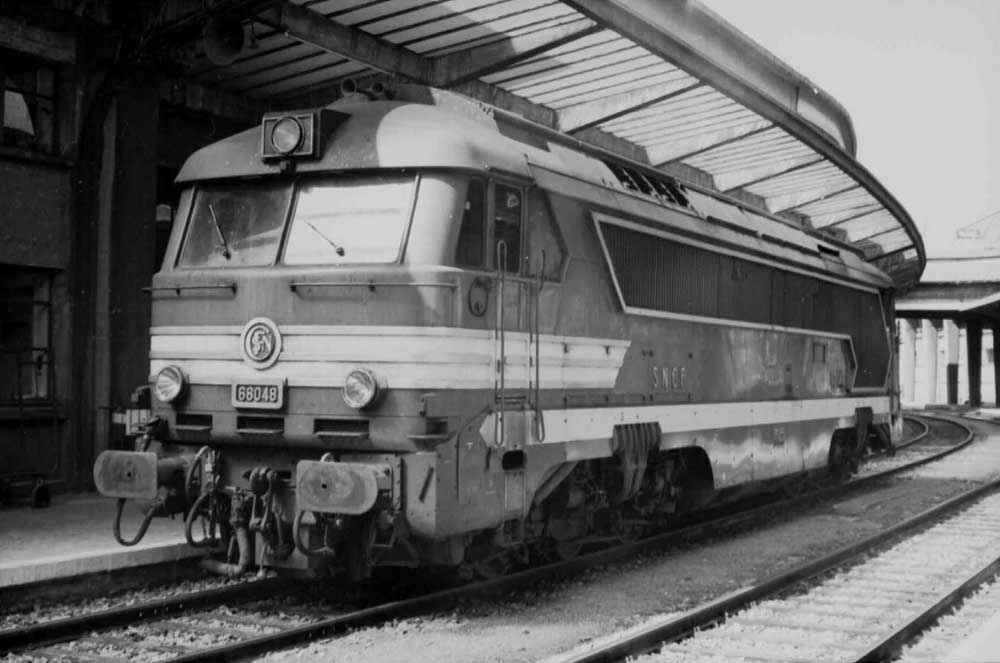
68000 mid-life overhauls and 68500 modifications circa 1977-1982
Between 1977 and the end of 1981 the Sotteville workshops undertook mid-life modifications to the 68000 locomotives and improvements to the 68500 locomotives:
Further work was also carried out on the 68000 locomotives:the boilers and associated water tanks were removed, replaced by slabs of cast iron to maintain proper weight distribution (Classes 67300, 67400 & 72000 were fitted with electric train heating equipment supplied from the main alternator. Apart from a small batch of BB 63500 class the SNCF never equipped the first generation locomotives with generator of separate alternators for electric train heating purposes.)
the driving cabs also received structural modifications to provide better protection for the train crews, using BB 67400 principles. The original cabs were made only of a polyester laminated material, the new cabs main structure were of an all metal framework, similar to those on the newer BB 67400 Class with a polyester mask. This style was also applied to Classes 67000, 67200, 67300, 68000 & 68500, giving a more unified appearance to portions of the diesel fleet.
the number one cab had a second door fitted through the bulkhead to access the engine compartment (1985)
the couplers received modifications with the possibility of automatic couplers being installed at some point and simplification to the cabs wrap-round stainless steel styling took place, with metalwork replaced by a simple painted white panel. This simplification was also made to a number of the other early SNCF classes livery, adapted from the BB 67400 livery - the modernized Arzens livery studied by Jacques Cooper, designer of the first Paris Sud Est TGV.
the light package on the cab fronts now included red lights.
The 68500 locomotives did not benefit from the mid-life modifications, however the Hispano-Suiza hydrostatic transmission for the cooling fans was replaced by a BEHR assembly.Rework of the underbody brake pipes
Removal of the door between the boiler and electrical compartments
Repositioning of the brake equipment within the boiler compartment
Installation of two 500 litre air tanks, utilising the space vacated by the removal of the water tanks between the bogies, the 1000 litre tank was removed from the radiator area
Placement of an emergency door behind the driver's position made possible by the repositioning of the brake equipment
Renovation of the side sheet metal by replacement with copper semi-stainless steel
Replacement on 68036 and following of the Hispano-Suiza hydrostatic transmission cooling fans by an Alsthom electromagnetic coupler identical to those on 68001 to 68035 (1983)
Automatic sanding equipment fitted.
During the later part of their careers the 68000/68500 locomotives benefited from addition of safety equipment applied to all SNCF series, traction/braking control, emergency braking control, DAAT, and Radio Sol Train.
The boiler compartment roofs were replaced, the original ones suffering from damage caused by humidity and ambient temperatures.
Sulzer 12LVA problems
As the Sulzer power units started to age a large number suffered cracks principally to the right of the number six cylinder and would constitute a major portion of repairs carried out on the LVA engines. Initially a type of reinforcement provided a successful repair to this problem. In 1980 the SNCF placed an order for 40 engine frames reinforced with a thicker plate (100 mm). As engines came in for repairs these new frames were used to replace the damaged ones. The fitting of studs without collars relieved stresses noted between the frames and stud, this had caused water leaks in the original design.
The original design of the connecting rod bearings led to damage and excessive wear to the crankshaft without position marking, sending metal particles into the lubricating oil. A redesigned connecting rod bearing was developed to remedy the problem with an improvement to the welds.
By the early 1990s spare parts (crankshafts, pushers etc) for the LVA engines were either becoming difficult to obtain or prohibitively expensive leading to the SNCF cancelling the second order for 40 reinforced engine frames from ACH. With no other LVA engines operating in railway service anywhere the SNCF began the process of withdrawing selected 68000 series locomotives to provide spares for other members of the Class.
Recognising that many of the 68000s had received mid-life overhauls and were in better condition than the 68500 series, the SNCF chose to re-engine a dozen of these 68000s with AGO engines taken from retired 68500 series locomotives.
Because the AGO V12 DSHR had benefitted from updated studies and applied to the V16 ESHR engines fitted to the younger and more powerful CC 72000 series and the SNCF had more SACM AGO powered locomotives in service than the Sulzer LVA powered locomotives the spares for the AGO engines more readily available. Thus in 1993 the Quatre-Mares workshops began the re-engining process.
The SNCF also sourced some second-hand AGO engines from Gabon which allowed for the recovery of crankshafts and peripheral parts. However the cooling circuit connection points were different leading to extra work for the Quatre-Mares workshops. This is for example the case of the engine in 68540.
Between 1993 - 1996 and 2000 - 2002, twelve 68000 locomotives were transformed into 68500 locomotives, as detailed below:
Original number / New number / Date of rebuild
68030 to 68529 10/12/1993
68022 to 68530 01/10/1994
68009 to 68531 03/28/1994
68024 to 68532 05/08/1994
68017 to 68533 04/14/1995
68085 to 68534 06/29/1995
68019 to 68535 05/24/1996
68004 to 68536 10/19/2000
68023 to 68537 05/31/2001
68005 to 68538 06/07/2001
68084 to 68539 03/22/2002
68039 to 68540 06/12/2002
Of note in this list is that of 68084 & 68085, these were two of the original AGO engined 68500s that were re-engined with the Sulzer 12LVA in 1984 and now saw the Sulzer engine replaced by the AGO V12 type!
The gap between 1996 & 2000 was due to the challenges of SNCF reorganizations, fluctuations in freight traffic and the demands of LGV infrastucture work.
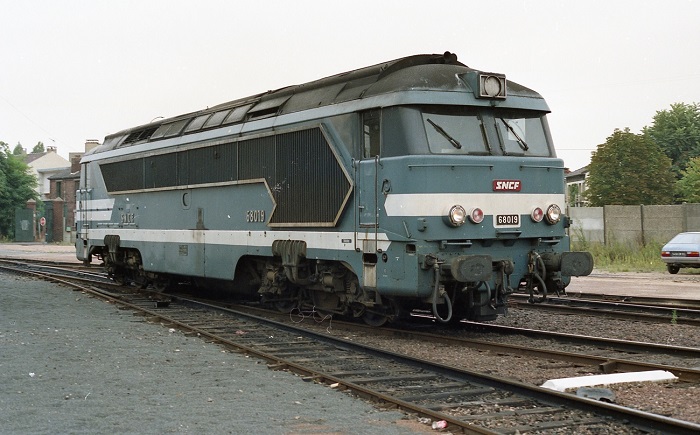

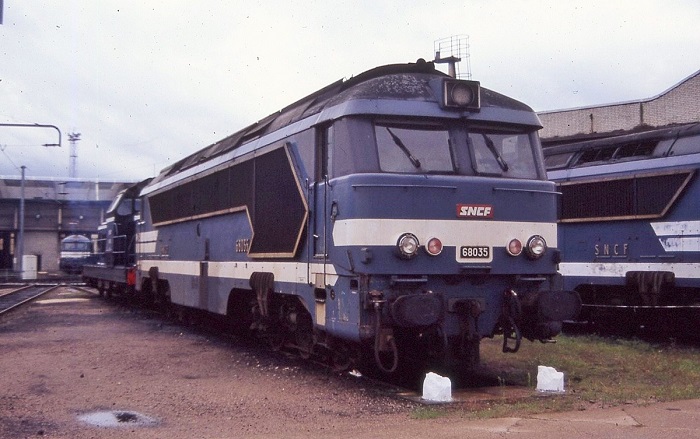
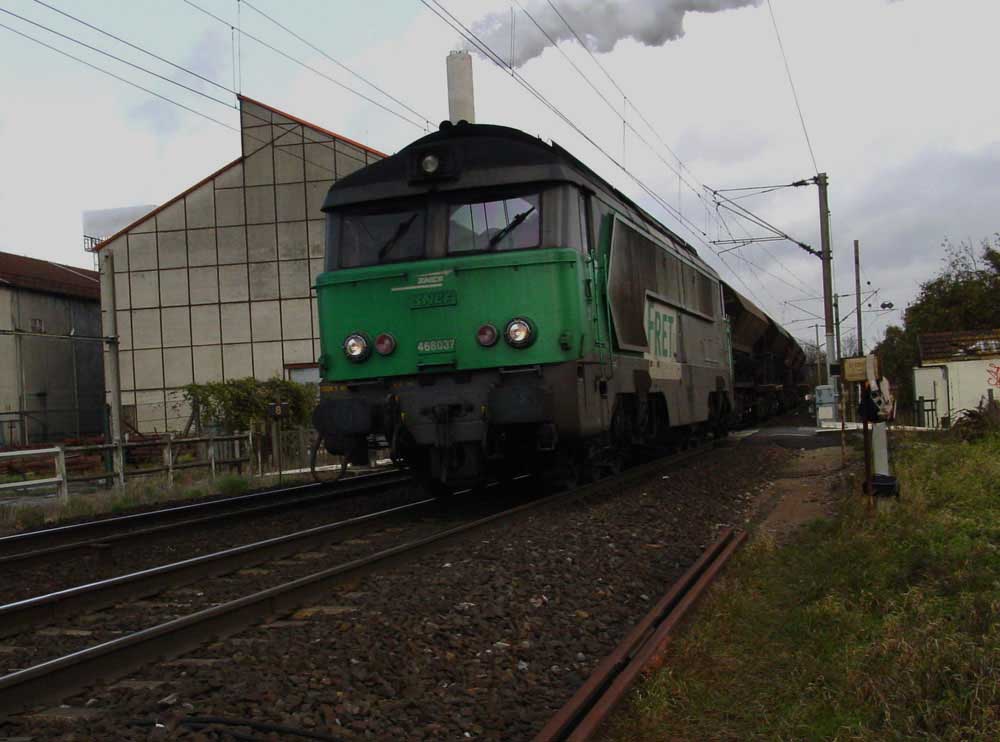

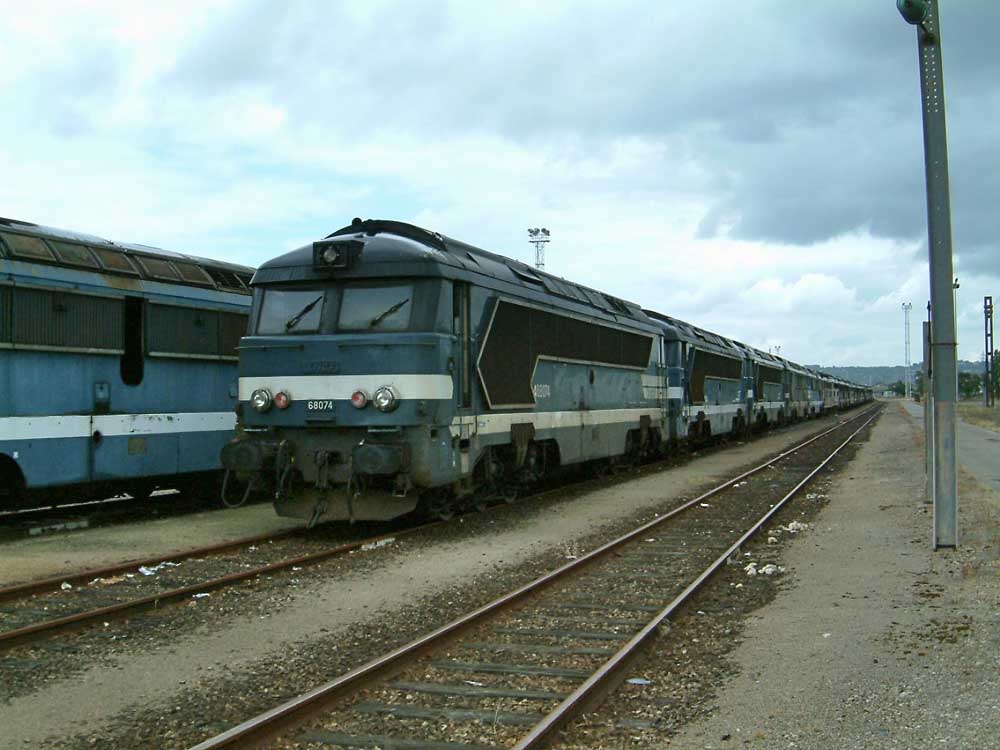
![]()
Class 68000 details
| Number | Date to service | Date withdrawn | Mileage at withdrawal | AGO replaced by Sulzer LVA | - | 68001 | 15/07/1963 | 01/09/2003 | 3,713,016 | - | - | 68002 | 05/09/1963 | 13/09/2002 | 4,399,845 | - | - | 68003 | 26/10/1963 | 13/12/2004 | 4,436,996 | - | - | 68004 | 13/11/1963 | - | 3,738,784 (at 12/95) | to 68536 23/10/2000 | - | 68005 | 12/12/1963 | - | - | to 68501 | - | 68006 | 08/01/1964 | 19/04/2004 | 3,947,498 | - | - | 68007 | 08/02/1964 | 01/10/2004 | 3,958,816 | - | - | 68008 | 29/02/1964 | 31/07/2002 | 3,748,162 | - | - | 68009 | 01/06/1964 | - | - | to 68531 27/01/1994 | - | 68010 | 06/06/1964 | 17/12/2005 | 4,046,623 | - | - | 68011 | 24/06/1964 | 28/12/2001 | 4,217,122 | - | - | 68012 | 30/06/1964 | 19/04/2004 | 3,848,304 | - | - | 68013 | 30/05/1964 | 31/10/2003 | 4,035,985 | - | - | 68014 | 16/06/1964 | 19/04/2004 | 3,700,380 | - | - | 68015 | 19/06/1964 | 19/04/2004 | 4,098,945 | - | - | 68016 | 26/06/1964 | 01/06/1993 | 3,261,154 | - | - | 68017 | 04/08/1964 | - | - | to 68533 14/02/1995 | - | 68018 | 28/10/1964 | 19/04/2004 | 3,870,333 | - | - | 68019 | 06/11/1964 | - | - | to 68535 28/05/1996 | - | 68020 | 06/11/1964 | 04/11/2004 | 3,782,414 | - | - | 68021 | 15/12/1964 | 26/12/2002 | 3,770,317 | - | - | 68022 | 16/12/1964 | - | - | to 68530 02/11/1993 | - | 68023 | 06/03/1965 | - | - | to 68537 05/01/2001 | - | 68024 | 27/03/1965 | - | - | to 68532 05/08/1994 | - | 68025 | 25/03/1965 | 04/04/2003 | 3,294,412 | - | - | 68026 | 17/02/1965 | 15/09/2003 | 4,054,096 | - | - | 68027 | 05/04/1965 | 20/12/2001 | 3,122,400 | - | - | 68028 | 08/03/1965 | 16/06/1982 | - | - | - | 68029 | 30/04/1965 | 01/10/2004 | 3,309,077 | - | - | 68030 | 23/05/1965 | - | - | to 68529 10/12/1993 | - | 68031 | 12/05/1965 | 19/12/2003 | 4,465,841 | - | - | 68032 | 16/06/1965 | 27/12/2000 | 3,798,655 | - | - | 68033 | 13/07/1965 | 20/12/2001 | 3,746,706 | - | - | 68034 | 30/07/1965 | 01/02/2004 | 4,254,388 | - | - | 68035 | 27/06/1965 | 19/12/2003 | 3,833,350 | - | - | 68036 | 06/09/1965 | 01/10/2004 | 3,974,500 | - | - | 68037 | 30/07/1965 | 15/12/2005 | 4,211,853 | - | - | 68038 | 20/09/1965 | 15/12/2005 | 4,225,237 | - | - | 68039 | 25/09/1965 | - | - | to 68540 06/12/2002 | - | 68040 | 07/10/1965 | 30/07/1965 | 3,935,581 | - | - | 68041 | 12/12/1965 | 28/12/2001 | 3,631,099 | - | - | 68042 | 28/10/1965 | 28/12/2005 | 4,144,329 | - | - | 68043 | 30/12/1965 | 19/04/2004 | 3,825,550 | - | - | 68044 | 19/02/1965?? | 26/05/2003 | 3,585,003 | - | - | 68045 | 08/12/1965 | 01/10/2004 | 4,346,940 | - | - | 68046 | 14/05/1966 | 01/10/2004 | 3,746,173 | - | - | 68047 | 24/02/1966 | 04/04/2003 | 3,387,189 | - | - | 68048 | 01/02/1966 | 01/10/2004 | 3,332,871 | - | - | 68049 | 28/05/1966 | 19/04/2004 | 3,475,678 | - | - | 68050 | 01/07/1966 | 01/02/2004 | 3,370,580 | - | - | 68051 | 20/05/1966 | 01/01/2005 | 3,273,043 | - | - | 68052 | 19/07/1966 | 19/04/2004 | 3,221,055 | - | - | 68053 | 29/07/1966 | 19/04/2004 | 3,403,352 | - | - | 68054 | 01/09/1966 | 13/12/2000 | 3,293,264 | - | - | 68055 | 22/03/1966 | 05/08/2002 | 3,209,205 | - | - | 68056 | 29/09/1966 | 01/02/2004 | 3,332,370 | - | - | 68057 | 29/10/1966 | 31/08/2001 | 3,205,490 | - | - | 68058 | 17/11/1966 | 01/09/2003 | 3,144,543 | - | - | 68059 | 01/04/1966 | 01/09/2003 | 3,272,553 | - | - | 68060 | 01/04/1966 | 01/10/2004 | 3,451,050 | - | - | 68061 | 14/05/1967 | 16/12/2005 | 4,008,811 | - | - | 68062 | 02/07/1967 | 09/12/1976 | - | - | - | 68063 | 23/09/1967 | 03/02/1997 | 2,906,927 | - | - | 68064 | 23/12/1966 | 19/04/2004 | 3,459,850 | - | - | 68065 | 28/01/1967 | 01/10/2004 | 3,349,998 | - | - | 68066 | 25/02/1967 | 01/02/2004 | 3,431,162 | - | - | 68067 | 16/12/1966 | 01/10/2004 | 3,290,741 | - | - | 68068 | 31/12/1966 | 01/01/2005 | 3,176,581 | - | - | 68069 | 05/02/1967 | 15/02/1999 | 3,053,791 | - | - | 68070 | 19/02/1967 | 19/04/2004 | 3,174,838 | - | - | 68071 | 25/04/1967 | 19/04/2004 | 3,165,495 | - | - | 68072 | 12/05/1967 | 19/04/2004 | 3,178,358 | - | - | 68073 | 30/11/1966 | 01/09/2003 | 2,971,131 | - | - | 68074 | 28/07/1967 | 19/04/2004 | 3,020,076 | - | - | 68075 | 06/11/1967 | 19/04/2004 | 3,236,829 | - | - | 68076 | 13/01/1968 | 26/05/2003 | 2,846,018 | - | - | 68077 | 17/02/1968 | 25/03/1993 | 2,375,913 | - | - | 68078 | 11/05/1968 | 01/09/2003 | 3,024,634 | - | - | 68079 | 05/07/1968 | 28/12/2005 | 3,333,641 | - | - | 68080 | 20/07/1968 | 01/07/2001 | 2,720,812 | - | - | 68081 | 02/08/1968 | - | - | - | STF Loc Infra SLI | 68082 | - | 01/10/2004 | - | from 68529 | - | 68083 | - | 05/08/2002 | - | from 68525 | - | 68084 | - | - | - | from 68508 to 68539 22/03/2002 | - | 68085 | - | - | - | from 68510 to 68534 29/06/1995 | - |
![]()
Two locomotives would be withdrawn prematurely:
68062: on August 4th 1974 68026 was diagrammed to work an evening Caen - Rennes passenger service with one van and five coaches. The train was well patronised with about 300 passengers. At about 9.25pm on a sharp curve just east of Dol-de-Bretagne station the entire train derailed, with the locomotive and some vehicles falling onto their sides. The curve was restricted to 40 km/h, however the train entered the curve at about 115 km/h. Heavy lifting equipment was required to clear the scene and ensure that all bodies had been recovered. The driver and the conductor were killed in the accident, regrettably a high level of alcohol was found in the driver's blood. It was also reported that the train initially failed to stop at several stations, including the one before Dol de Bretagne: Pontorson (Manche) and the train was required to set back.
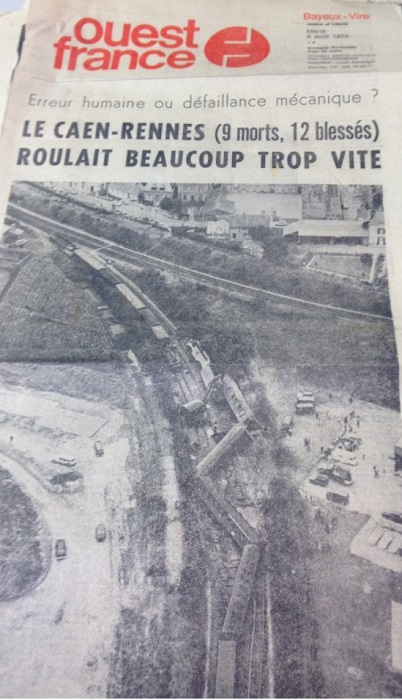
68028: On May 27th 1982 two trains collided on Xertigny viaduct. 68028 fell off the viaduct after hitting construction equipment, suffering heavy damage, while 68501 derailed but remained on the viaduct. The accident resulted in the death of two people and injured seven others.
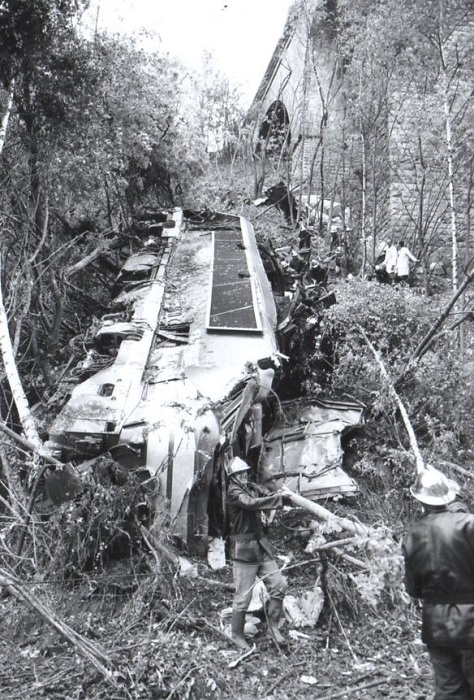
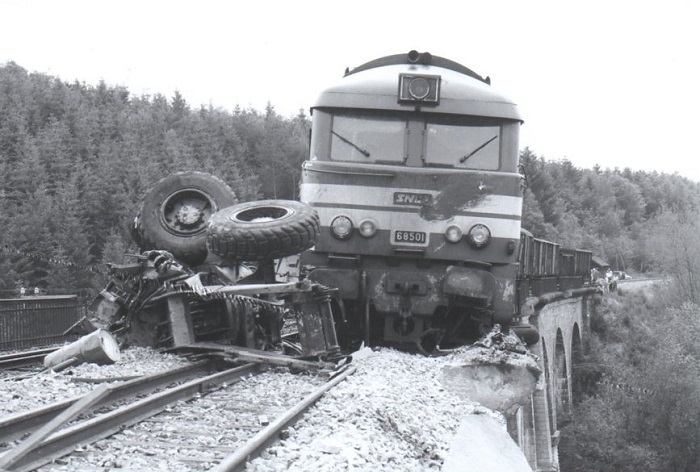
![]()
Class 68501 details
| Number | Date to service | Date withdrawn | Mileage at withdrawal | Sulzer LVA replaced by AGO | - | 68501 | 12/12/1963 | to 68005 | - | - | - | 68502 | 28/05/1964 | 23/06/1994 | 3,374,584 | - | - | 68503 | 19/06/1964 | 01/09/2003 | 3,911,658 | - | - | 68504 | 04/07/1964 | 17/06/2010 | 3,747,671 | - | - | 68505 | 25/11/1964 | 15/12/2003 | 3,910,359 | - | - | 68506 | 02/04/1965 | 04/11/2011 | 3,941,017 | - | - | 68507 | 30/07/1965 | 03/12/2010 | 4,012,311 | - | - | 68508 | 13/11/1965 | to 68084 | - | - | - | 68509 | 08/11/1966 | 04/11/2002 | 3,580,672 | - | - | 68510 | 02/12/1966 | to 68085 | - | - | - | 68511 | 21/10/1966 | 23/06/1994 | 3,167,519 | - | - | 68512 | 29/10/1966 | 17/06/2010 | 3,834,714 | - | - | 68513 | 29/11/1966 | 11/03/1996 | 3,359,683 | - | - | 68514 | 11/02/1966 | 11/03/1994 | 2,885,869 | - | - | 68515 | 21/01/1967 | 29/11/2002 | 3,495,508 | - | - | 68516 | 13/01/1967 | 11/03/1994 | 3,219,733 | - | - | 68517 | 21/01/1967 | 11/03/1996 | 3,413,714 | - | - | 68518 | 03/03/1967 | 27/12/2004 | 3,448,638 | - | - | 68519 | 10/03/1967 | 30/12/2004 | 3,357,760 | - | - | 68520 | 24/03/1967 | 09/03/2011 | 3,451,201 | - | - | 68521 | 27/04/1967 | 08/07/2010 | 3,523,687 | - | - | 68522 | 22/06/1967 | 04/09/2009 | 3,583,405 | - | - | 68523 | 14/07/1967 | 01/07/2011 | 3,632,822 | - | - | 68524 | 27/09/1967 | 01/12/2009 | 3,546,744 | - | - | 68525 | 30/11/1967 | to 68083 | - | - | - | 68526 | 12/12/1967 | 27/12/2004 | 3,898,220 | - | - | 68527 | 27/01/1968 | 19/06/2010 | 3,898,220 | - | - | 68528 | 12/04/1968 | 01/08/2003 | 3,090,869 | - | - | 68529 (1) | 20/06/1968 | to 68082 | - | - | - | 68529 (2) | ex 68030 | 14/10/2003 | 3,950,850 | 10/1993 | - | 68530 | ex 68022 | 29/12/2005 | 3,887,027 | 01/1994 | - | 68531 | ex 68009 | 01/07/2011 | 3,819,058 | 03/1994 | - | 68532 | ex 68024 | 13/12/2004 | 3,741,107 | 05/1994 | - | 68533 | ex 68017 | 06/07/2010 | 4,526,044 | 04/1995 | - | 68534 | ex 68085 | 15/12/2003 | 4,073,075 | 06/1995 | - | 68535 | ex 68019 | 19/06/2010 | 4,312,259 | 05/1996 | - | 68536 | ex 68004 | 17/05/2011 | 4,636,341 | 10/2000 | - | 68537 | ex 68023 | 04/07/2011 | 3,549,976 | 05/2001 | - | 68538 | ex 68005 | 30/03/2011 | 4,790,250 | 06/2001 | - | 68539 | ex 68084 | 30/03/2011 | 4,449,046 | 03/2002 | - | 68540 | ex 68039 | 01/07/2011 | 4,161,732 | 06/2002 | - |
![]()
The first link below features A1A A1A 68081 diesel engine room, which was working in multiple with A1A A1A 68540 on the train. 68081 was the last Sulzer 12LVA24 engine to operate on the SNCF, with it’s round load regulator and would have been similar to what the BR Class 48 sounded like:
Acceleration after the stop at Moulins sur Allier station.
The 2nd link below provides video with sound of preserved SNCF 68540 on October 3rd 2015 working a tourist train between Orléans and St Chély:
Video of interior of 68540 from pneumatic room to electric room and diesel room
This last link features 68540 in June 2021, during a return journey from Bourges to Orléans, with 68540 between 100 and 102 kph (max speed for touristic trains on French main lines), on hilly profile crossing Sologne between Vierzon and Orléans.
Video in rear cab of 68540 June 2021.
![]()
Resources:
Le Train special 2/96 'Les Diesel de Ligne' (BB 69000, CC 70000 A1A-A1A 68000/68500 - tome 1)
Trains du Sud Ouest (website)
Railfaneurope.net (website - The European Railway Server)
J G Ampeau - thanks for all the help.
Other French classes: SNCF(PLM) 262 BD 1 , SNCF 65500 , Early French shunters
Page added March 9th 2002.
Last updated January 25th 2024
Back to the Sulzer country lists page
Return to site menu